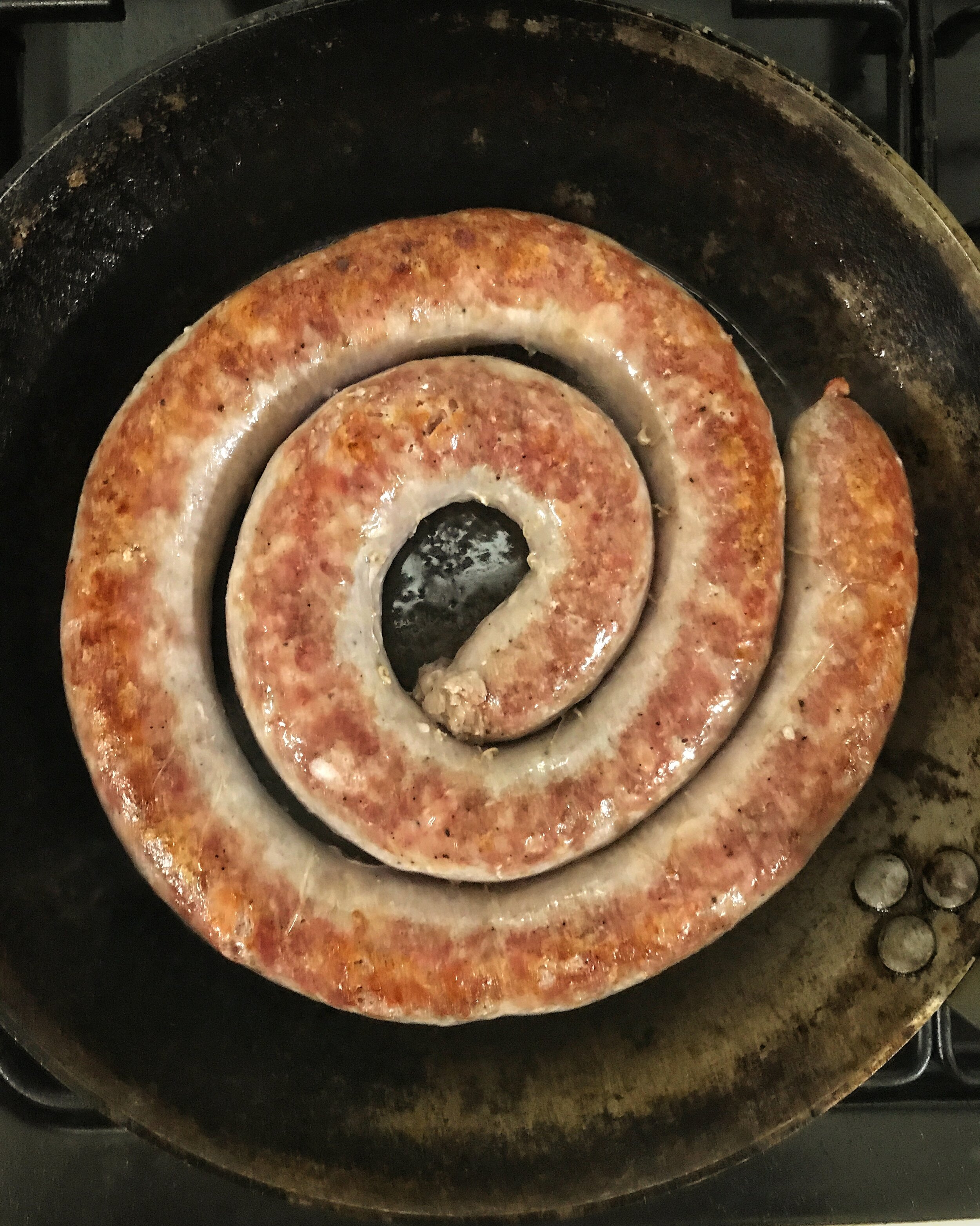A Time of Grace- a French Harvest of Saucisse de Toulouse
The Forest at Camont November 2019
November wraps her foggy cloak around Camont like a felted room in which song birds still sing muffled by damp leaves and darker mornings. Chica and I take abbreviated walks to the hens to make sure the little automatic door (thank you Chicken Guards!) has adjusted to the time change. I am grateful for the extra hour of light in the morning. I regret the darker evenings.
I build the first fires in the jaunty kitchen stove. September and October were both so warm this is the first time we’ve needed to; more to remove the damp than raise the temperature. There are four stères ( a cubic meter) of dry oak wood waiting the first real cold, and the piles of old oak branches and trimmed acacia trees scattered around the park will be gathered and brought in for fueling a winter barbecue or two. Just like the pique-niques I wrote about in the latest Saveur website here, cooking outside can be a four season event. I use my small Portuguese beehive oven all year round when I want to make something smokey and spicy, or just perfectly cook a côte de boeuf.
I take stock of the late garden, knowing that the compost pile will benefit mostly from the last tomato plants and the straggling pumpkin vines. The September planted mâche and roquette are now filling out promising winter salads for the next few months; small upright fennel settle in for the slow growing season. Mâche has many names in English- Lamb’s Lettuce being the one I know but Valerianella locusta is the official name. It’s a fabulous bright, dark, and mild-tasting green that ruffles out a plate. Sometimes you just need a leaf or two.
So, of course, that leads us to Cassoulet. Right? All roads at Camont lead to Cassoulet at this time of year. But something that might go with all the rest of the seasonal goodness—pumpkins, winter greens, and especially cassoulet—is an easy solid recipe for Saucisse de Toulouse. Nothing is as easy or taste as delicious as these fat juicy porky sausages served with a creamy Purée de Pommes de Terre or nestled in a plate of slow-cooked haricots Tarbais. If you want more beany instruction, then my Cassoulet; A French Obsession cookbook is for you. Rancho Gordo will even send you a couple pounds of freshly harvested California Cassoulet beans (ie. Tarbais); if you live outside of the US the book is available via Amazon here.
I feature this recipe in the Cassoulet book but here’s a jump start from our latest Camp Charcuterie: France workshop. Five students from around the world gathered here at Camont for a week of Whole-Carcass Butchery and French Farmstead Charcuterie. One of the first things we make after learning to separate the shoulder and belly from the ham, is to make some fresh sausage or Saucisse de Toulouse. Want to know more about learning Butchery and Charcuterie in France? Check out our 2020 dates on the Camp Charcuterie page here.
Li, Carlos and Dominique making Saucisse de Toulouse at Camont
Saucisse de Toulouse
Fresh Pork Sausage
By French Law, a Saucisse de Toulouse has to follow a number of serious defining points to be able to be sold under the name. However, there is nothing stopping you from making these succulent fat fresh pork sausages at home. Of all the products we make during a Camp Charcuterie week, these are by far my favorite. It’s like eating a piece of the juiciest roasted pork with a built-in sauce of pan juices and gravy, all in a crusty brown casing. Remember, your sausage will only be as good as the pork that you buy. Go to the butchers, ask for some fresh shoulder meat and some unsalted belly, and see if they’ll sell you some 32-35mm casings as well. Otherwise, just make some thick patties and enjoy!
House-made Saucisse de Toulouse from Camp Charcuterie:France
Saucisse de Toulouse1 kilo Pork- 80% lean 20% fat ratio the easiest way is to by 800g lean shoulder meat and 200g belly
14 g Salt- or 1.4% Coarse sea salt works best
2 g Pepper- or .2% Make sure to grind it fresh!
Mix all of the above together before grinding on an 8mm hole size plate. Once ground, mix well together until there is some binding or stickiness develops. Stuff into natural hog casings 32-35mm size, if using lamb casings we call these chipolatas.
Do not link. Instead make a nice spiral that will fit in your pan. Let rest or temper over night int eh refrigerator uncovered or under a tea towel, you want the casings to be dry before cooking. Cook over a high enough heat to brown the casings, then turn and lower the heat, cooking until just down- a pale pink blush of medium pork in the center.
That’s it. No wine, no garlic, no spices. The idea is to show off the high quality well grown local pork- usually 10-12 months old at slaughter. In France, people still appreciate the meatiness of these sausages. Let me know what you think!


